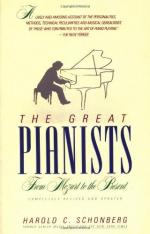
|
| Name: _________________________ | Period: ___________________ |
This test consists of 15 multiple choice questions and 5 short answer questions.
Multiple Choice Questions
1. What son of a Hungarian official was born in 1811 became a priest in 1865 but had no authority to celebrate mass or hear confession?
(a) Sigismond Thalberg.
(b) Adolf von Henselt.
(c) Friedrich Chopin.
(d) Franz Liszt.
2. What is the term used to describe an elegant drawing room used in formal receptions that is different in layout and size than a public hall or auditorium used for concerts?
(a) Studio.
(b) Stage.
(c) Salon.
(d) Concerto.
3. What is an English piano manufacturer founded in 1728 by Burkat Shudi and continued after his death in 1773?
(a) Hammel and Sons.
(b) Broadwood and Sons.
(c) Steinway.
(d) Henselt and Sons.
4. When was Vladimir von Pachmann born?
(a) 1848.
(b) 1902.
(c) 1798.
(d) 1865.
5. What pianist performed at four and memorized and played all the Beethoven symphonies at eight on piano?
(a) William Sterndale Bennett.
(b) Louis Moreau Gottschalk.
(c) Felix Mendelssohn.
(d) Clara Schumann.
6. What German Romantic composer of orchestral and choral works was born in 1809 in Hamburg?
(a) Felix Mendelssohn.
(b) Ignaz Moscheles.
(c) Friedrich Kalkbrenner.
(d) Carl Czerny.
7. Chopin introduced changes in fingering and what that remained stylish into the next century?
(a) Chords.
(b) Keys.
(c) Fugues.
(d) Pedaling.
8. How old was Anton Rubinstein when he debuted?
(a) 13.
(b) 9.
(c) 15.
(d) 11.
9. What pianist was born en route between Cassel and Berlin and played with most superficial brilliance?
(a) Johann Nepomuk Hummel.
(b) Friedrich Kalkbrenner.
(c) Ignaz Moscheles.
(d) Carl Czerny.
10. When did the piano become the most popular instrument to be played publicly?
(a) 1798.
(b) 1772.
(c) 1814.
(d) 1800.
11. What German composer and a notable piano virtuoso of the Romantic period studied under Julius Benedict, Carl Czerny, and Simon Sechte?
(a) William Sterndale Bennett.
(b) Antoine de Kontski.
(c) Louis Moreau Gottschalk.
(d) Theodor Döhler.
12. What is the name of a term used to describe a form of music in which themes successively repeat?
(a) Arpeggio.
(b) Fugue.
(c) Style galant.
(d) Legato.
13. Who embellished a Chopin nocturne, prompting Chopin to tell him to play it as he wrote it or not at all?
(a) Friedrich Chopin.
(b) Adolf von Henselt.
(c) Bertold Hummel.
(d) Franz Liszt.
14. What musical term refers to playing notes of a chord one after another rather than at one time?
(a) Legato.
(b) Arpeggio.
(c) Fugue.
(d) Stacatto.
15. What musical instrument consists of one or more sets of pipes sounded by means of compressed air, played by means of one or more keyboards, and capable of producing a wide range of musical effects?
(a) Lute.
(b) Organ.
(c) Harpsichord.
(d) Clavichord.
Short Answer Questions
1. What great pianist played piano as he sat erect and formal with minimal movement and earned the nickname Old Arpeggio?
2. Where did Paderewski debut in 1887?
3. Who invented the piano?
4. Who married composer Robert Schumann, wore black in his memory, and was the authority on his music?
5. Who freed Hans von Bulow from a lack of spontaneity to become his first great pupil?
|
This section contains 464 words (approx. 2 pages at 300 words per page) |

|




